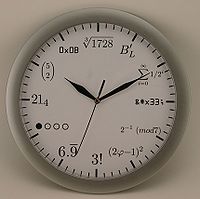Course:MATH103/Archive/2010-2011/207/Lectures/Lecture23
| Faculty of Science Department of Mathematics | |
|---|---|

| |
| Course Pages | |
| Course Policies | |
| Math Solvers | |
| Exams | |
| Quizzes | |
| Assignments | |
| Lectures | |
Lecture 23
Readings For This Lecture
- Chapter 10, pages 199 to 208 (up to subsection 10.5)
Summary
Group 4: Add a summary of the lecture in this space. Include examples, discussion, and links to external sources, if desired.
Exercises
1. Determine which of the following sequences are convergent or divergent. Justify your answer.
2. Determine which of the following series are convergent or divergent. Justify your answer.
3. To what value does the alternating series
converge as ?
4. The trunk of a tree gets wider by adding a new growth every year. (In cross section, these show up as “rings”, one ring for each year). The first year the trunk has radius 1 inch. In the second year the radius increases by 1/2 inch, in the third year by 1/4 inch, and so on every year. What is the trunk radius for a 20 year old tree? For a 50 year old tree? How big can the radius of the trunk get if the tree keeps growing this way indefinitely? What will the cross-sectional area of the trunk be after a long time?
5. A symmetric flat snowflake starts out as a square of size 1 millimeter. Every time step a new branch is added on the furthest edge of each of the previous branches. Each branch is a little square whose area is times the area of its “parent branch”. (See Figure) What is the area of the snowflake after a very long time? For what values of is this final area finite? What is the final area in the case that ?
6. Determine which of the following integrals converges or diverges. Justify your answer.
7. “Gabriel’s Horn” is the surface of revolution formed by rotating the graph of the function about the -axis for . Find the volume of air inside this shape and show that it is finite. When we cut a cross-section of this horn along the xy plane, we see a flat area which is wedged between the curves and . Show that this “cross-sectional area” is infinite. Find an integral expression for the surface area of this horn, and show that the surface area is infinite.




















